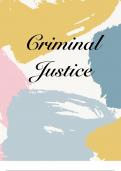Class notes
Notes for Chapter 1-5 Intro To Criminal Justice
- Course
- CJAD 101
- Institution
- Columbia College (CC )
These are the notes for chapters 1-5 in Intro to criminal justice. They are organized and highlighted to provide for easy navigation.
[Show more]



